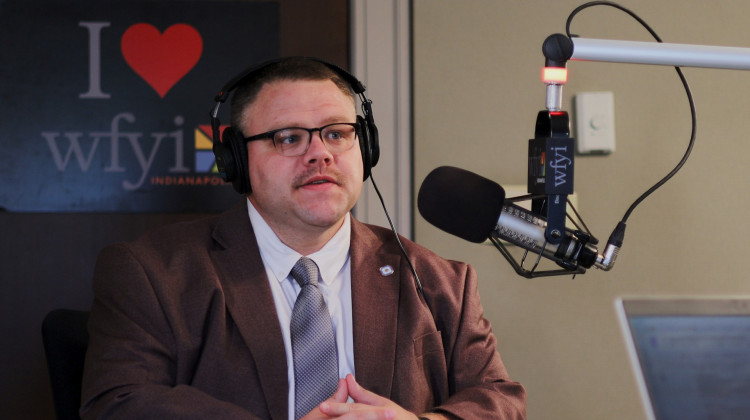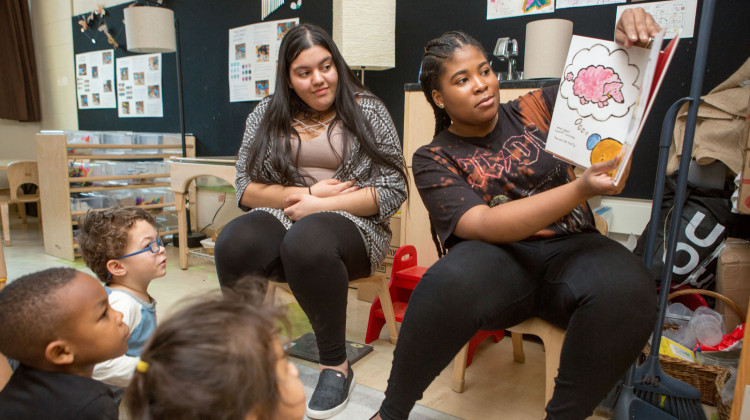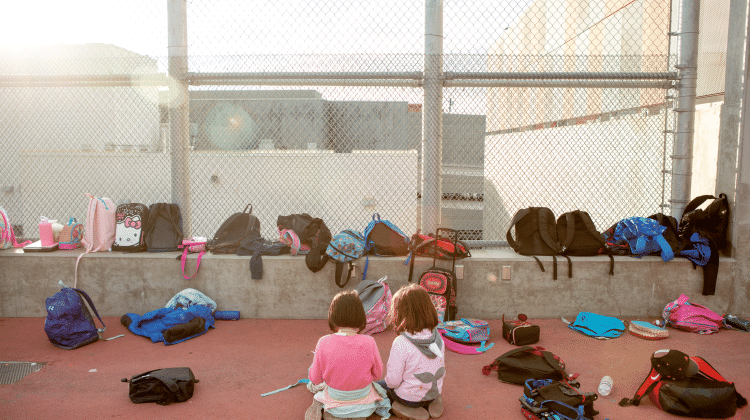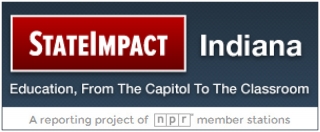
IPS Superintendent and Principal Andrea Hunley at last month's teacher of the year announcement at School 2.
James Vaughn / ChalkbeatIndianapolis could be the latest district to follow a national trend toward more independent schools
Kelly Bentley didn’t mince words when addressing detractors of the Indianapolis Public School Board’s recent push to shift the district toward becoming a system of independently-run elementary and high schools with less central office control.
The school board member’s message: It’s happening. So get ready.
“For those who are against decentralization and against driving more decision-making and resources to schools, the train has left the station,” Bentley posted to Facebook last week. “It’s time to jump on board or be left behind.”
The creation of a system in which, as the board wrote, “IPS’s central administration exists solely to support the work of teachers and schools,” was approved unanimously by the school board in March. A group charged with making a final recommendation to the board for how it should work in practice met for the first time on July 3, even though that was the day the district, and most businesses, observed as the Independence Day holiday.
What exactly school autonomy will look like for IPS is not yet clear. A plan isn’t expected to be presented to the school board until this fall. But the fact that the board is insistent that it will happen could mean big changes for the district.
Proponents of the idea — the strategy has gained traction nationally, especially in large urban districts facing budget cutbacks and competition — say driving decision-making and budgeting down to the school level will empower principals to make good decisions and ultimately lead to better student achievement.
Others have grave doubts, saying they fear converting to independently-run IPS schools is a move to turn the district into the equivalent of a charter school network, which could mean lower teacher pay and less job security.
Meanwhile, Superintendent Lewis Ferebee says what’s guiding him is the chance for better schools where kids earn better test scores. Almost two-thirds of IPS’s nearly 65 schools are rated a D or F by the state based on student test scores.
“It’s not a privatization strategy,” Ferebee said. “It’s not an anti-union strategy. It’s a school improvement strategy. Anytime you can shift the decision closer to where the service is occurring, you have a better opportunity to hit the mark.”
Portfolio model has gained traction nationally
Urban districts across the country are looking toward decentralization as a panacea to help solve both their budget woes and as a way to improve learning.
The argument for autonomous district schools is similar to that of the charter school movement: Supporters say students can be served better if principals are given more control over their budgets and freed from the weighty chains of central office bureaucracy.
One model gaining traction in urban cities is the “portfolio strategy,” a model that distributes money based on the number and type of child in each building, putting principals in charge of their budgets. In that situation, the central office’s role is to make sure schools measure up and make changes only when they don’t. For a portfolio school district, the central office works more like a charter school sponsor: its main role is to make sure schools keep improving and to provide support services.
“You’re encouraging schools to own decisions,” said Georgetown University research professor Marguerite Roza, a fellow with the Seattle-based Center for Reinventing Public Education. “The idea here is rather than ignore that schools are very human-intensive operations, to actually harness that humanness and put it to work.”
More than 45 districts — New Orleans, Denver, Baltimore and New York among them — are portfolio-style systems, according to CRPE, which has researched the strategies and helps schools implement them.
Perhaps the most well-known example of an autonomous school district is New Orleans, the first district in the country composed entirely of charter schools.
Roza, who has been consulting with IPS on the portfolio strategy, said it’s unlikely that Indianapolis would end up looking like New Orleans, a place where she said the changes have resulted in a “fragile” dynamic in neighborhoods. IPS told Chalkbeat it was not paying Roza to consult.
Advocates in New Orleans say the reimagined system has yielded better results and given parents more control. Critics say losing a centralized school system has created a lack of accountability and removed critical community institutions from needy neighborhoods.
“New Orleans isn’t the best exemplar,” Roza said. “What we’ve seen in these other cities like Boston and Denver and Houston is a gradual progression in increased school-level control in decisions, places where they assign what that means for their district.”
In Denver, the district continues to roll out its plan for creating a system of autonomous schools. In May, Denver Public Schools announced that all principals next year will be able to choose their own curricula, testing programs, teacher training plans and other programs. It’s long had a system of autonomous charter schools and “innovation” schools.
Crafting a homegrown plan?
IPS board members say they’ve been watching how other cities implement portfolio strategies and learning from their struggles and successes.
Ferebee said he’s committed to creating a plan that’s specific to Indianapolis — and only Indianapolis.
“I want to be clear that it is not my approach to say we have to replicate Denver or we have to replicate New Orleans or wherever,” Ferebee said. “The complexities, opportunities and challenges of Indianapolis are unique. I don’t think it to be a situation where people think we’re trying to make ourselves into somebody else. That’s not the end game here.”
Those critical of the plan, including IPS board member Gayle Cosby, said they fear exactly that.
At the first meeting of the autonomy committee, the IPS team discussed CRPE’s 18-month plan for implementing a portfolio strategy. About 80 teachers, community members, union employees and others attended the meeting despite the holiday. Cosby previously expressed frustration at not being picked to serve on the committee.
Autonomy, she said, is a becoming a cover for other changes.
“The word has gradually been co-opted,” Cosby wrote in her blog. “Instead of reflecting a wide variety of options that could be weighed carefully and selected based on what suits our city’s needs, the ed reformers in this city use the word ‘autonomy’ to refer to anything associated with (CRPE’s) portfolio school model, which is the true agenda of the current IPS board majority.”
Mary Ann Sullivan, one of two board members on the autonomy committee, said they’re using information from CRPE and looking at results in other cities as a guide — not a prescription.
“That (18-month) timeline has nothing to do with IPS,” Sullivan said. “If we’re doing this, we don’t want to do it with our eyes shut, in some formulaic way. We want to do it with the understanding that every place you do this work, it’s going to be different.”
Plus, Bentley said, board members each have different ideas about what autonomy means. For instance, she said she feels strongly that certain programs should be required in all schools. IPS parents rallied against the district’s recent decision to eliminate instrumental music programs at some schools. The district later reversed the changes— a decision IPS said it originally made in the name of school autonomy.
“I am a firm believer that every elementary school ought to have art and music and physical education and instrumental music,” Bentley said. “I would never want a school to be able to arbitrarily decide (it’s) not going to do music at all.”
Despite differences of opinion, Sullivan said she believes there is strong support for pushing more decision-making to schools.
“If you take out the semi-big word autonomy and talk about this stuff in plain language, I can guarantee there is strong support for driving decisions (to the schools) near principals, teachers and parents,” Sullivan said. “This is not action that is sudden or impulsive.”
Not a new concept for IPS
IPS has tried out school autonomy in the past — even if it wasn’t always called that.
A 2014 state law, which Ferebee advocated for, gave IPS the ability to form compacts with charter schools to independently manage district schools. Phalen Leadership Academy will in August manage School 103 on the East side under that arrangement.
But even before that, former Superintendent Eugene White pursued a portfolio strategy of sorts in 2011 when he planned an aggressive expansion of the district’s magnet programs. He argued that creating more choices for parents would act as a stopgap to combat the district’s rapidly waning enrollment.
Those magnet schools had the ability to hire their own teaching staffs and develop unique academic programs specific to their buildings. The move was cheered even by White’s critics, including then-state Superintendent Tony Bennett.
In the mid-1990’s, the district tried out a strategy called “site-based decision making,” which also had a goal of driving more decisions to schools. It launched in 1994 with eight schools participating.
Bentley, who first joined the board in 1998, recalls some principals and teachers worked well together under the model, and many parents were engaged in making school-level decisions on committees.
“It worked well in some schools and didn’t work well in others,” Bentley said. “What schools had authority over was pretty limited and they certainly didn’t have any control over staffing. If they did, it was very limited.”
Big changes ahead for school budgets
Pushing more money to the classroom — funding schools based on the number of students enrolled and their needs rather than by how many staff are assigned — is a major tenet of the portfolio school strategy. School 109 second-grade teacher Leah Putnam, who is a National Board Certified teacher, said that sounds good but she’s seen this play out in unexpected ways before.
Putnam taught until last year at Chicago Public Schools, which uses “local school councils” to oversee schools with committees of parents, teachers, principals and even students to make budget and curriculum decisions.
When CPS funded schools based on student enrollment, Putnam said it had unintended consequences for teachers.
“Per-student funding sounds great on paper, but can be devastating when budgets are cut or are less than projected,” Putnam said. “Even worse, human resources are pitted against purchasing material things like computers, or even toilet paper.”
Dave Dresslar, a former superintendent and retired director of the Center for Excellence in Leadership of Learning at the University of Indianapolis, is leading the board’s autonomy committee. He said he believes that IPS needs to spend its money more thoughtfully. He said autonomous schools might make that possible.
“Centralized control is designed to make things more efficient but local control may make it more effective,” Dresslar said. “Making financial decisions at the school level means that the money that’s spent will be for priorities at that school as opposed to district-wide priorities. In that regard, you’ll have a more efficient use of those limited funds.”
Does IPS need to completely transform itself into a portfolio-style system in order to redirect its spending priorities? Jennifer Beeching-Gaines, a 2015 IPS teacher of the year finalist, said she doesn’t think so.
“I think autonomy in certain areas is a good thing, but I don’t see the need to go to such extremes as the school board wants to do,” said Beeching-Gaines, who is an English teacher for one of IPS’s alternative programs. “Why doesn’t IPS just ask the principals what they want and go from there? If I were a principal, that’s what I would want to happen.”
Teachers are hopeful but skeptical
Tina Ahlgren, IPS’s 2014 Teacher of the Year, said she is cautiously optimistic about what the board’s vision for the school district will mean for the district’s nearly 2,500 teachers.
Ahlgren has raised alarms in the past about IPS’s struggles to recruit and retain teachers. The district started the summer with more than 300 vacant teacher and staff jobs.
Part of what attracted Ahlgren to accept a job at IPS, she said, instead of offers she received from charter schools was the decent job security it offered: If she was moved from one school, chances were there was another place for her to go within the district.
“I worry if we’re already struggling with teacher retention, what happens if we lose what little job protection we have?” Ahlgren said. “Are we going to struggle even more with teacher retention or recruitment? People are looking for that security of having a larger system to back you up.”
But she acknowledged giving schools more independence might help improve teaching.
“Right now, there are a lot of one-size-fits-all approaches that are handed down from IPS that work great in some buildings and for some teachers and for some schools but not for all,” Ahlgren said. “(We’d have) flexibility to determine things like timing of when we teach what, and covering the curriculum with a different order or emphasis.”
Rosalilia Stewart, a Spanish teacher at Arsenal Technical High School, said she is worried the changes will make the teachers union all but irrelevant.
“It’s all leading towards charters and privatization of our public schools,” Stewart said. “We just need to make our union stronger.”
Ferebee rejected that assessment. He thinks the new system will be better for teachers.
“It’s something I support and believe in,” Ferebee said. “The one thread that I (hear) consistently from staff is that they feel like the bureaucracies or the top-down approach of managing schools or school leaders is a barrier to student achievement.”
Chalkbeat Indiana is a nonprofit news site covering educational change in public schools.
 DONATE
DONATE







 Support WFYI. We can't do it without you.
Support WFYI. We can't do it without you.